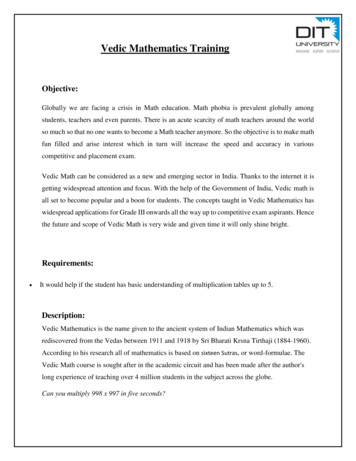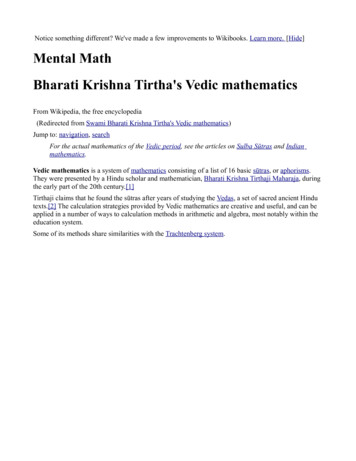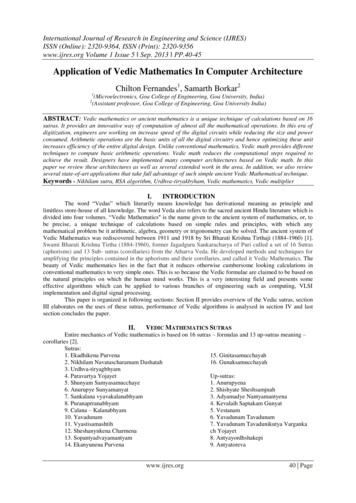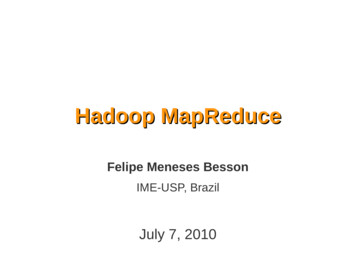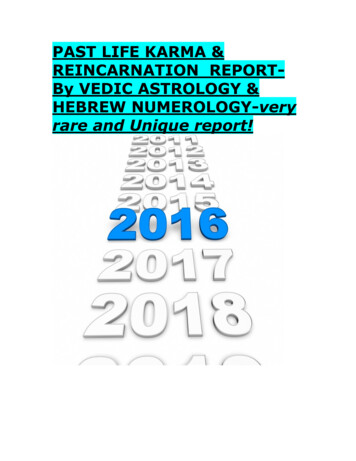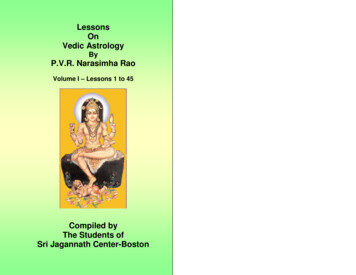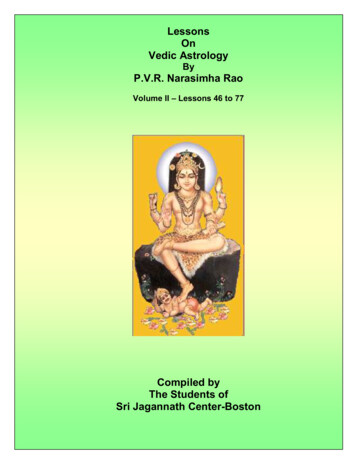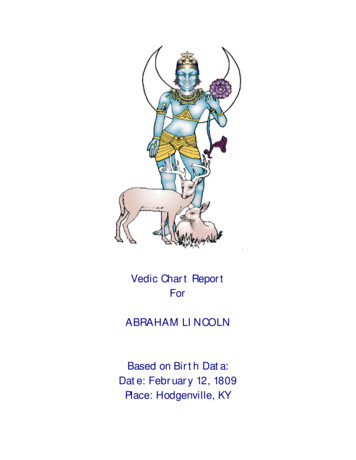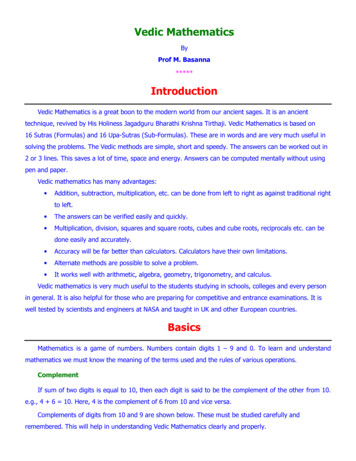
Transcription
Vedic MathematicsByProf M. Basanna*****IntroductionVedic Mathematics is a great boon to the modern world from our ancient sages. It is an ancienttechnique, revived by His Holiness Jagadguru Bharathi Krishna Tirthaji. Vedic Mathematics is based on16 Sutras (Formulas) and 16 Upa-Sutras (Sub-Formulas). These are in words and are very much useful insolving the problems. The Vedic methods are simple, short and speedy. The answers can be worked out in2 or 3 lines. This saves a lot of time, space and energy. Answers can be computed mentally without usingpen and paper.Vedic mathematics has many advantages: Addition, subtraction, multiplication, etc. can be done from left to right as against traditional rightto left. The answers can be verified easily and quickly. Multiplication, division, squares and square roots, cubes and cube roots, reciprocals etc. can bedone easily and accurately. Accuracy will be far better than calculators. Calculators have their own limitations. Alternate methods are possible to solve a problem. It works well with arithmetic, algebra, geometry, trigonometry, and calculus.Vedic mathematics is very much useful to the students studying in schools, colleges and every personin general. It is also helpful for those who are preparing for competitive and entrance examinations. It iswell tested by scientists and engineers at NASA and taught in UK and other European countries.BasicsMathematics is a game of numbers. Numbers contain digits 1 – 9 and 0. To learn and understandmathematics we must know the meaning of the terms used and the rules of various operations.ComplementIf sum of two digits is equal to 10, then each digit is said to be the complement of the other from 10.e.g., 4 6 10. Here, 4 is the complement of 6 from 10 and vice versa.Complements of digits from 10 and 9 are shown below. These must be studied carefully andremembered. This will help in understanding Vedic Mathematics clearly and properly.
Complements from 10Digit123456789Complement987654321Complements from 9Digit012345678Complement987654321Addition of two digitsSum of two positive digits is equal to the sum of the digits with positive sign.E.g., 2 3 5, 6 3 9, etc.Sum of two negative digits is equal to the sum of the digits with negative sign.E.g.,(–2) (–3) –5, (–6) (–3) –9, etc.Sum of a positive digit and a negative digit is equal to the difference between the digits with the signof larger digit. E.g., 2 (–3) –1, (–6) 3 –3, etc.Subtraction of two digitsSubtraction is nothing but negative addition. To subtract one digit from another digit, change the signof the digit to be subtracted and add the two digits.E.g., 2 – 3 2 (–3) –1, 6 – 3 6 (–3) 3, etc.Multiplication of two digitsProduct of two positive digits is equal to the product of the digits with positive sign.E.g., 2 x 3 6, 6 x 3 18, etc.Product of two negative digits is equal to the product of the digits with positive sign.E.g., (–2) x (–3) 6, (–6) x (–3) 18, etc.Product of a positive digit and a negative digit is equal to the product of the digits with the negativesign.E.g., 2 x (–3) –6, (–6) x 3 –18, etc.Subtraction from 100, 1000, 10000, In Vedic mathematics, powers of 10, viz., 10, 100, 1000, are used as base. When a number issubtracted from a base we get the complement of that number from that base.E.g., 100 – 36 64. Here, 64 is the complement of 36 from base 100.1000 – 36 964. Here, 964 is the complement of 36 from 1000.
To find the complement of a number from a base we need not subtract the number from the baseevery time. We can use the Vedic Sutra "All from 9 and the last from 10", known as Nikhilam Sutra. It isalso called "All from 9", in short. The following examples explain the use of this Sutra.1. Consider the number 853 and base 1000.Applying All from 9,8 from 9 is 9 – 8 15 from 9 is 9 – 5 4And Last from 10,3 from 10 is 10 – 3 7Thus, 147 is the complement of 853 from base 1000. Note that 147 853 1000.2. Consider the number 52 and base 1000. Here, 1000 has 3 zeros. So, we rewrite 52 as 052 andapply Nikhilam.All from 9,0 from 9 is 9 – 0 95 from 9 is 9 – 5 4Last from 10,2 from 10 is 10 – 2 8Thus, 948 is the complement of 52 from base 1000. Again, note that 948 52 1000.Similarly, the complement of any number can be computed. The calculations shown above are onlyguidelines. We need not write all the steps. The calculations can be done mentally after a little practice. Trysome more cases by yourselves.AdditionIn Mathematics addition and subtraction are simple and easy operations. But, addition is easier thansubtraction. These topics are covered here for the reason that Vedic Mathematics allows us to add, subtractand multiply numbers from left to right or right to left. This is the greatness of Vedic Mathematics.Left to rightWe write the numbers from left to right. Also, we read numbers from left to right. But, in traditionalmathematics addition, subtraction and multiplication are done from right to left. Would it not be fine if wecan do these operations from left to right? In some problems we need to know first 2 or 3 digits. Here weshall see how this could be done!AdditionAs said earlier addition is the simplest and easiest operation. We shall see here how addition could bedone from left to right. The method is given below.Method Write the numbers one below the other. Add the digits column by column from left to right or right to left.
If the sum exceeds 9, retain last digit and carry over other digits to left. Compute the final answer.Example 1: Add 548 236 198.5485485482 36235236 198 198 19 88868 6211 2982Working from left to right (Mental work)Step 1: 1 2 5 8. Write as shownStep 2: 9 3 4 16.–"–Step 3: 8 6 8 22.–"–Add the two rows to get the final answer.Example 2: Add 5678 3728 4379.56785678567856783728372837283728 4379 4379 4379 43792662662611111266511111121 3785Working from left to right (Mental work)Step 1: 4 3 5 12. Write as shownStep 2: 3 7 6 16."Step 3: 7 2 7 16."Step 4: 9 8 8 25."Add the two rows to get the final answer.SubtractionSubtraction is little harder than addition. But it is made simpler using Vedic Mathematics techniques.Instead of subtracting numbers directly we convert the number to be subtracted into Vinculum and thensubtract. The method adopted is explained below.
Method: Write numbers one below the other. Check the lower digit from left to right. If it is larger than the upper digit, put a star on the itsprevious digit to increase its value by 1.e.g., 1– 1 1 2,2– 2 1 3, etc. If the lower digit is smaller than the upper digit write the difference between digits. If the lower digit is larger than the upper digit write the complement of the difference betweenthe digits. (Alternately, add the complement of the lower digit to the upper digit)Example1: Subtract: 224 – 192.2 2 4- 1* 9 20 3 2Working from left to right (Mental work)Step 1: 9 2. A (*) is put on 1. So, 1* 1 1 2.Step 2: 2 – (1 1) 0, (Write this in 1st column)Step 3: 2 9. So no (*), 2 – 9 10 3. (2nd column)(Alternately, complement of 9 from 10 is 1 and 1 2 3)The answer is 32.Step 4: 4 2. So, 4 – 2 2, (3rd column)Example 2: Subtract: 322 – 197.322- 1* 9* 7125The answer is 125.Working from left to right (Mental work)Step 1: 9 2. A (*) is put on 1. So, 1* 1 1 2.7 3. A *(*) is put on 9. So, 9* 9 1 10.Step 2: 3 – (1 1) 1, (Write this in 1st column)Step 3: 2 9*.So, 2 – (9 1) 10 2. (2nd column)(Alternately, complement of 10 from 10 is 0 and 0 2 2)Step 4: 2 7So, 2 – 7 10 5, (3rd column)(Alternately, complement of 7 from 10 is 3 and 3 2 5)Final answer is 125.MultiplicationIn mathematics multiplication is harder than addition and subtraction. In Vedic Mathematics we havesimpler methods. Before taking up them we will discuss some special cases.Multiplication by 11Multiplication of a number by 11 is very easy. It is as good as addition. This method is explained below.Method Sandwich the given number between zeros. Starting from left end add the digits taking them in pairs. If the total exceeds 9, retain the first digit and carry over the other digits to the left.
Example1: Multiply 135 x 11Working from left to right (Mental work)Write the multiplicand as shownAddition of digits in pair is shown below.and add the digits in pair.0 1 1,135 x 111 3 4,0135 03 5 8,14855 0 5Thus, 135 x 11 1485Example 2: MultiplyWorking from left to right (Mental work)58403 x 11Addition of digits in pair is shown below.58403 x 1105840300 5 5, 5 8 13, 8 4 12,4 0 4, 0 3 3, 3 0 3.53243311642433Thus, 58403 x 11 642433The above method can be extended to multiply any number by numbers like 111, 1111, 11111, etc.Sandwich the given number between a pair of zeros and add the digits in threesome (taking three at atime).Example 3: Multiply 123 x 111123 x 111001230013653Working from left to right (Mental work)Addition of digits in three-some is shown below.0 0 1 1, 0 1 2 3, 1 2 3 6,2 3 0 5, 3 0 0 3Thus, 123 x 111 13653Example 4:Working from left to right (Mental work)Multiply 5786 x 111Addition of digits in threesome is shown below.5786 x 1110 0 5 5, 0 5 7 12,005786005 7 8 20, 7 8 6 21,5201461221642246Thus, 5786 x 111 6422468 6 0 14, 6 0 0 6.
Multiplication by 12This is similar to the one discussed earlier. But, there is a slight difference. This employs the VedicSutra "Ultimate and twice the penultimate". According to this, we must add twice the penultimate digit tothe ultimate digit.Consider the number 32. Here, penultimate digit is 3 and the ultimate digit is 2. By the above Sutra,the required sum 3 x 2 2 8.Example 1: Multiply 123 x 12Working from left to right (Mental work)123 x 12Write the multiplicand as shown and add twice the penultimate01230digit to ultimate digit.14760 x 2 1 1, 1 x 2 2 4,Thus, 123 x 12 14762 x 2 3 7, 3 x 2 0 6.Example 2: Multiply 396 x 12Working from left to right (Mental work)396 x 1203960Write the multiplicand as shown and add twice the penultimatedigit to ultimate digit.35420 x 2 3 3, 3 x 2 9 15,1219 x 2 6 24, 6 x 2 0 12.4752Thus, 396 x 12 4752This method can be extended for multiplication with 13, 14, 15, , 19 with little modification. Insteadof twice we have to take three times, four times, etc. Try this!Ekadhikena MultiplicationThis is another simple method. The Vedic Sutra used in this method is "One more than the previousone" – Ekadhikena. Two different cases arise here.Case I – Last digits adding to 10.The numbers used in this method must obey the following conditions.Both the numbers must have the same previous digit(s).The sum of the last digits must be 10.Numbers like 54 and 56, 42 and 48, 23 and 27, 34 and 36 form the examples.Method Divide the answer space into LHS and RHS by Place a slash (/) or a colon (:). Use Ekadhikena (Previous digit 1) to the digit on the LHS.
Write the product of last digits on the RHS. Take care to see that RHS has two digits, as it should be. (Digit rule) Remove the slash or colon.Example 1:Example 2:Example 3:Multiply 51 x 59Multiply 66 x 64Multiply 123 x 127Same previous digit: 5,Same previous digit: 6,Same previous digits: 12,Sum of last digits: 1 9 10.Sum of last digits: 6 4 10. Sum of last digits: 3 7 10.51 x 5966 x 64123 x 1275 x (5 1) / 1 x 96 x (6 1) / 6 x 412 x (12 1) / 3 x 730 / 09Thus, 51x59 3009.42 / 24Thus, 66 x 64 4224.156 / 21Thus, 123 x 127 15621.Note that 0 has been added on RHS.Case II – Squaring of numbers ending with 5.When the numbers are equal and end with 5, they satisfy both the conditions. Then the product of thenumbers gives the square of that number. Thus, the square of a number ending with 5 can be computedas above. In all such cases RHS will always be 25. These computations can be done mentally.Example 1:Example 2:Example 3:Find the square of 35.Find the square of 75.Find the square of 155.Previous digit 3Previous digit 7Previous digits 1535275215523 x (3 1) / 257 x (7 1) / 2515 x (15 1) / 2556 / 25240 / 2512 / 25Thus, 352 1225.Thus, 752 5625.Thus, 1552 24025.Ekanyunena MultiplicationEkanyunena is a Vedic Sutra which states that "One less than the previous one". This Sutra is useful inmultiplying a number with multipliers having only 9's (9, 99, 999, 9999, .). This is also a quick methodand done mentally within no time. The answer can be written in one line.Method Place a slash (/) or a colon (:) to separate answer into two parts, LHS and RHS. Subtract 1 from the multiplicand (Ekanyunena) and write it on LHS. Write the complement of multiplicand (from the base of multiplier) on RHS.
Remove the slash or colon.Three different situations need our attention.Case I: Both multiplicand and multiplier having same number of digits.Example 1: Multiply 4 x 9Working from left to right (Mental work)4x9LHS 4 – 1 3 (Ekanyunena)4–1/6RHS 10 – 4 6 (Complement of 4 from 10)36Thus, 4 x 9 36Example 2: Multiply 76 x 99Working from left to right (Mental work)76 x 99LHS 76 – 1 75 (Ekanyunena)76 – 1 / 24RHS 100–76 24 (Complement of 76 from 100)7524Thus, 76 x 99 7524Example 3: Multiply 353 x 999Working from left to right (Mental work)353 x 999LHS 353 – 1 352 (Ekanyunena)353 – 1 / 647RHS 1000 – 353 647 (Complement of 353 from 1000)352647Thus, 353 x 999 352647Case II: Multiplier having more number of digits than multiplicand.In this case, we equalize the number of digits both in multiplicand and multiplier by prefixing requirednumber of zeros with the multiplicand.Example 1: Multiply 6 x 99Working from left to right (Mental work)06 x 99LHS 6 – 1 5 (Ekanyunena)6-1 / 94RHS 100–06 94 (complement of 06 from 100)594(We can directly write the complement of 06 94)Thus, 6 x 99 594Example 2: Multiply 35 x 999Working from left to right (Mental work)035 x 999LHS 35 – 1 3435-1 /
Vedic Mathematics is a great boon to the modern world from our ancient sages. It is an ancient technique, revived by His Holiness Jagadguru Bharathi Krishna Tirthaji. Vedic Mathematics is based on 16 Sutras (Formulas) and 16 Upa-Sutras (Sub-Formulas). These are in words and are very much useful in solving the problems. The Vedic methods are simple, short and speedy. The answers can be worked .


